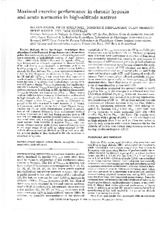Maximal exercise performance in chronic hypoxia and acute normoxia in high-altitude natives
Fecha
1995Autor
Favier, Roland
Spielvogel, Hilde
Desplanches, Dominique
Ferretti, Guido
Kayser, Bengt
Hoppeler, Hans
Metadatos
Mostrar el registro completo del ítemResumen
Maximal O₂ uptake (VO₂max) was determined on a bicycle ergometer in chronic hipoxia (CH) and during acute exposure to normoxia (AN) in 50 healthy Young men who were born and had lived at 3,600 m altitude (La Paz, Bolivia). VO₂max was significantly improved (~8%) by AN. However, the difference in VO₂max measured in CH and AN (∆VO₂max) was lower than that reported in sea- level natives (SN) who exercised in chronic normoxia and acute hypoxia. It is shown that high-altitude natives (HN) and SN have a similar VO₂max in normoxia, but highlanders can attain a greater VO₂max when O₂ availability is reduced by alotitude exposure. In addition, in HN, the higher the subject’s VO₂max in hypoxia, the smaller his ∆VO₂max. These results contrast with the data obtained in 14 lowlanders acclimatized to high altitude who showed that their ∆VO₂max was positively related to their VO₂max in hypoxia, as previously reported in SN who exercised in acute hypoxia (A. J. Young, A. Cymerman, and R. L. Burse. Eur. J. Appl, Physiol. Occup. Physiol. 54:12-15, 1985). Furthermore, arterial O₂ saturation of HN behaved differently from acclimatized lowland natives, inasmuch as it fell less during exercise both in CH and AN. HN with high aerobic capacity display a lower exercise ventilation and a reduced arterial saturation, which could explain their inability to improve VO₂max with normoxia. Plasma lactate levels during maximal exercise were in the same range (8-10 mM) as values reported for SN. ∆Work efficiency reached 26-28% in CH as well as in AN, i.e., a value similar to that obtained in SN who exercised in normoxia or hypoxia.

